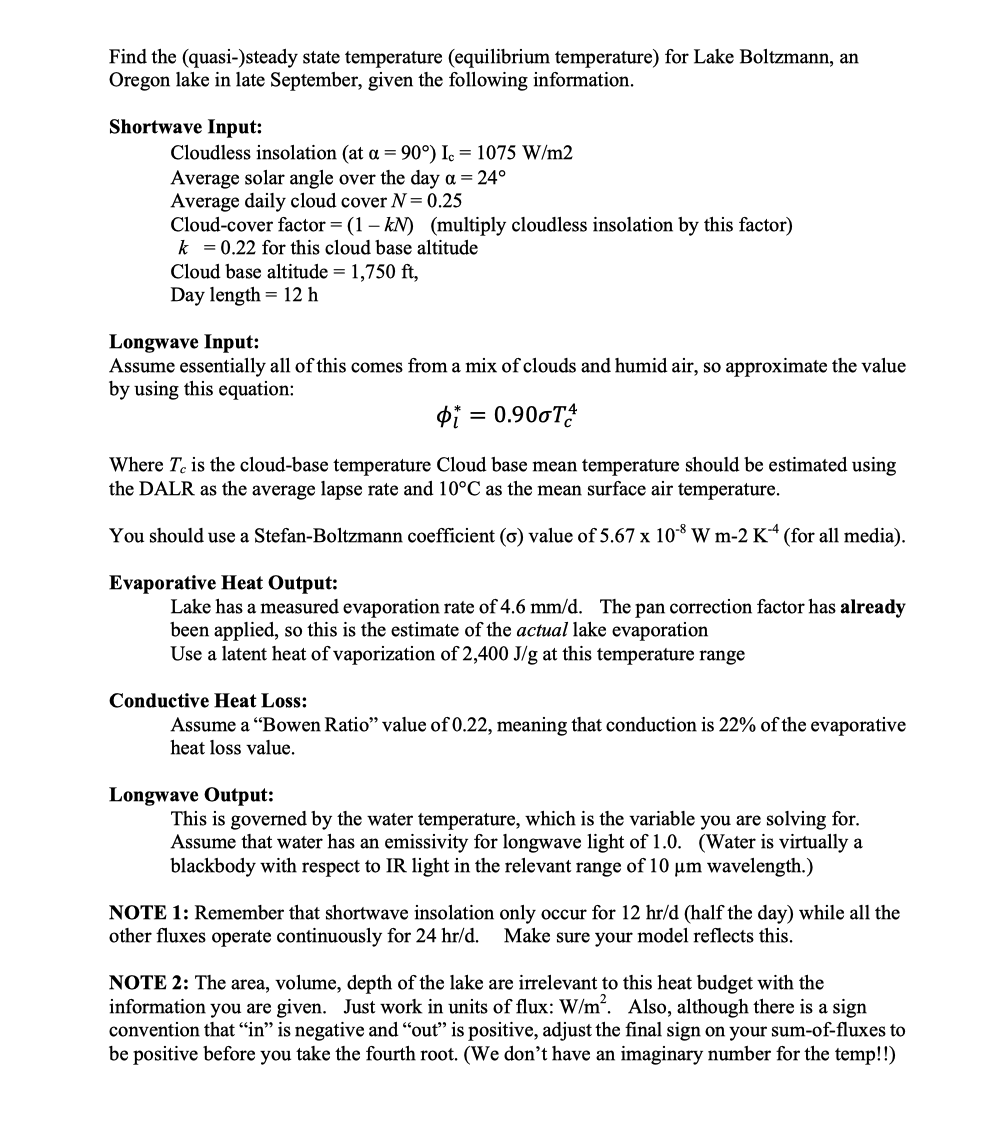 Please show the process and calculations for this.
Please show the process and calculations for this.
Find the (quasi-)steady state temperature (equilibrium temperature) for Lake Boltzmann, an Oregon lake in late September, given the following information. Shortwave Input: Cloudless insolation (at a = 90) I = 1075 W/m2 Average solar angle over the day a = 24 Average daily cloud cover N= 0.25 Cloud-cover factor = (1 - kN) (multiply cloudless insolation by this factor) k = 0.22 for this cloud base altitude Cloud base altitude = 1,750 ft, Day length = 12 h Longwave Input: Assume essentially all of this comes from a mix of clouds and humid air, so approximate the value by using this equation: * = 0.90oT4 = Where Te is the cloud-base temperature Cloud base mean temperature should be estimated using the DALR as the average lapse rate and 10C as the mean surface air temperature. You should use a Stefan-Boltzmann coefficient (6) value of 5.67 x 10-8 W m-2 K4 (for all media). Evaporative Heat Output: Lake has a measured evaporation rate of 4.6 mm/d. The pan correction factor has already been applied, so this is the estimate of the actual lake evaporation Use a latent heat of vaporization of 2,400 J/g at this temperature range Conductive Heat Loss: Assume a Bowen Ratio" value of 0.22, meaning that conduction is 22% of the evaporative heat loss value. Longwave Output: This is governed by the water temperature, which is the variable you are solving for. Assume that water has an emissivity for longwave light of 1.0. (Water is virtually a blackbody with respect to IR light the relevant range of 10 um wavelength.) NOTE 1: Remember that shortwave insolation only occur for 12 hr/d (half the day) while all the other fluxes operate continuously for 24 hr/d. Make sure your model reflects this. NOTE 2: The area, volume, depth of the lake are irrelevant to this heat budget with the information you are given. Just work in units of flux: W/m. Also, although there is a sign convention that in is negative and "out" is positive, adjust the final sign on your sum-of-fluxes to be positive before you take the fourth root. (We don't have an imaginary number for the temp!!) Find the (quasi-)steady state temperature (equilibrium temperature) for Lake Boltzmann, an Oregon lake in late September, given the following information. Shortwave Input: Cloudless insolation (at a = 90) I = 1075 W/m2 Average solar angle over the day a = 24 Average daily cloud cover N= 0.25 Cloud-cover factor = (1 - kN) (multiply cloudless insolation by this factor) k = 0.22 for this cloud base altitude Cloud base altitude = 1,750 ft, Day length = 12 h Longwave Input: Assume essentially all of this comes from a mix of clouds and humid air, so approximate the value by using this equation: * = 0.90oT4 = Where Te is the cloud-base temperature Cloud base mean temperature should be estimated using the DALR as the average lapse rate and 10C as the mean surface air temperature. You should use a Stefan-Boltzmann coefficient (6) value of 5.67 x 10-8 W m-2 K4 (for all media). Evaporative Heat Output: Lake has a measured evaporation rate of 4.6 mm/d. The pan correction factor has already been applied, so this is the estimate of the actual lake evaporation Use a latent heat of vaporization of 2,400 J/g at this temperature range Conductive Heat Loss: Assume a Bowen Ratio" value of 0.22, meaning that conduction is 22% of the evaporative heat loss value. Longwave Output: This is governed by the water temperature, which is the variable you are solving for. Assume that water has an emissivity for longwave light of 1.0. (Water is virtually a blackbody with respect to IR light the relevant range of 10 um wavelength.) NOTE 1: Remember that shortwave insolation only occur for 12 hr/d (half the day) while all the other fluxes operate continuously for 24 hr/d. Make sure your model reflects this. NOTE 2: The area, volume, depth of the lake are irrelevant to this heat budget with the information you are given. Just work in units of flux: W/m. Also, although there is a sign convention that in is negative and "out" is positive, adjust the final sign on your sum-of-fluxes to be positive before you take the fourth root. (We don't have an imaginary number for the temp!!)
 Please show the process and calculations for this.
Please show the process and calculations for this.





